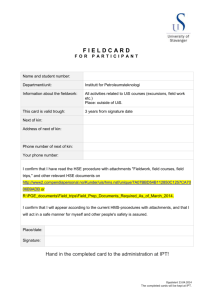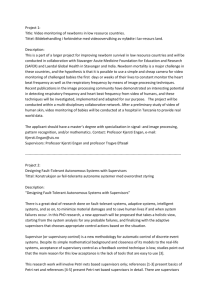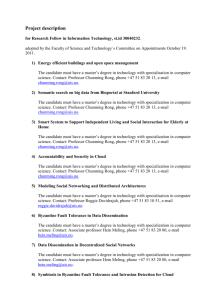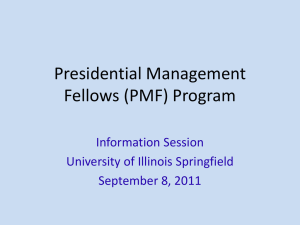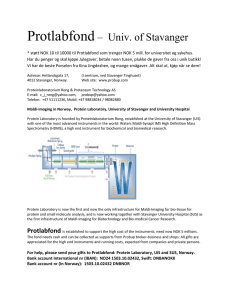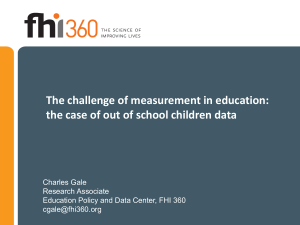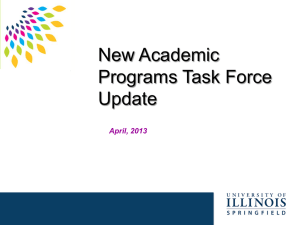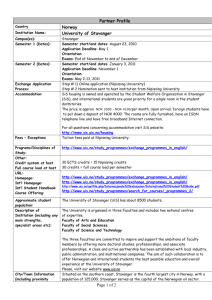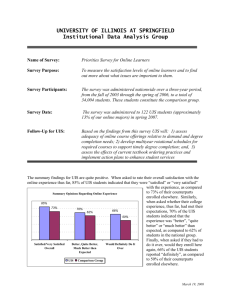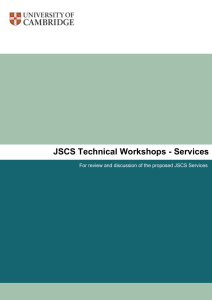IMPORTANT: The applicants must inform about which project(s) they
advertisement
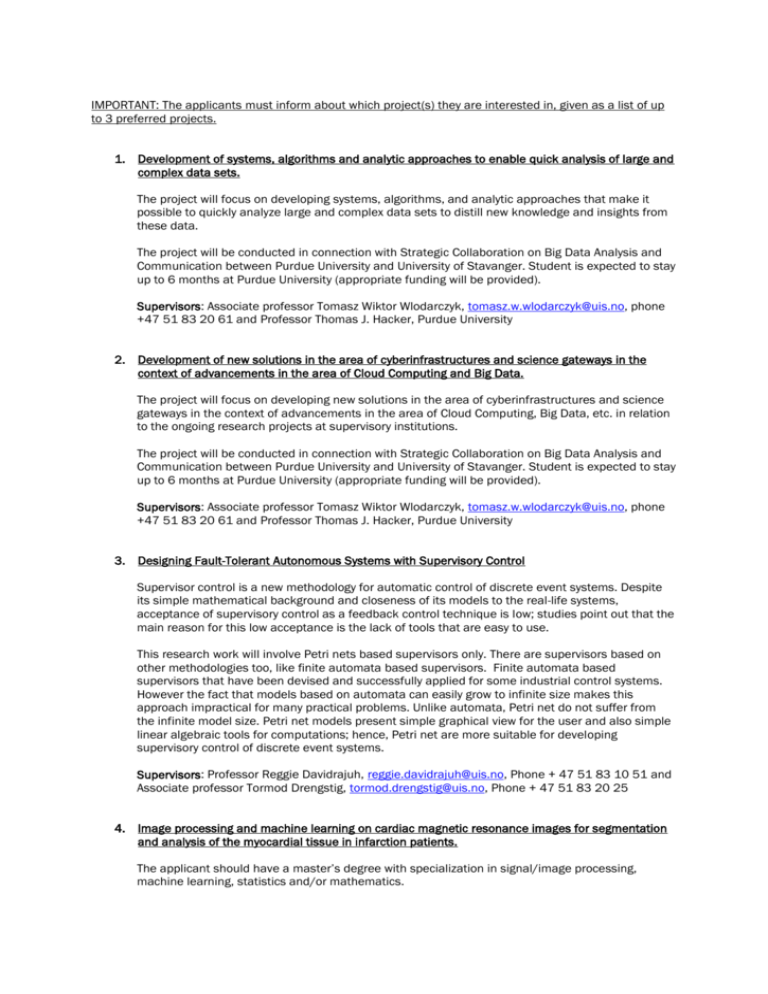
IMPORTANT: The applicants must inform about which project(s) they are interested in, given as a list of up to 3 preferred projects. 1. Development of systems, algorithms and analytic approaches to enable quick analysis of large and complex data sets. The project will focus on developing systems, algorithms, and analytic approaches that make it possible to quickly analyze large and complex data sets to distill new knowledge and insights from these data. The project will be conducted in connection with Strategic Collaboration on Big Data Analysis and Communication between Purdue University and University of Stavanger. Student is expected to stay up to 6 months at Purdue University (appropriate funding will be provided). Supervisors: Associate professor Tomasz Wiktor Wlodarczyk, tomasz.w.wlodarczyk@uis.no, phone +47 51 83 20 61 and Professor Thomas J. Hacker, Purdue University 2. Development of new solutions in the area of cyberinfrastructures and science gateways in the context of advancements in the area of Cloud Computing and Big Data. The project will focus on developing new solutions in the area of cyberinfrastructures and science gateways in the context of advancements in the area of Cloud Computing, Big Data, etc. in relation to the ongoing research projects at supervisory institutions. The project will be conducted in connection with Strategic Collaboration on Big Data Analysis and Communication between Purdue University and University of Stavanger. Student is expected to stay up to 6 months at Purdue University (appropriate funding will be provided). Supervisors: Associate professor Tomasz Wiktor Wlodarczyk, tomasz.w.wlodarczyk@uis.no, phone +47 51 83 20 61 and Professor Thomas J. Hacker, Purdue University 3. Designing Fault-Tolerant Autonomous Systems with Supervisory Control Supervisor control is a new methodology for automatic control of discrete event systems. Despite its simple mathematical background and closeness of its models to the real-life systems, acceptance of supervisory control as a feedback control technique is low; studies point out that the main reason for this low acceptance is the lack of tools that are easy to use. This research work will involve Petri nets based supervisors only. There are supervisors based on other methodologies too, like finite automata based supervisors. Finite automata based supervisors that have been devised and successfully applied for some industrial control systems. However the fact that models based on automata can easily grow to infinite size makes this approach impractical for many practical problems. Unlike automata, Petri net do not suffer from the infinite model size. Petri net models present simple graphical view for the user and also simple linear algebraic tools for computations; hence, Petri net are more suitable for developing supervisory control of discrete event systems. Supervisors: Professor Reggie Davidrajuh, reggie.davidrajuh@uis.no, Phone + 47 51 83 10 51 and Associate professor Tormod Drengstig, tormod.drengstig@uis.no, Phone + 47 51 83 20 25 4. Image processing and machine learning on cardiac magnetic resonance images for segmentation and analysis of the myocardial tissue in infarction patients. The applicant should have a master’s degree with specialization in signal/image processing, machine learning, statistics and/or mathematics. In many patients having suffered from myocardial infarction the risk of suffering cardiac arrest will be considered severe. As part of the examination of these patients cardiac magnetic resonance images are prepared. The damage extent and the working capacity of the heart is determined from several criteria, size of the scar tissue being among the most important to determine further treatment of the patient. This project is a part of collaboration between the biomedical signal and image processing group at the University of Stavanger and the department of cardiology at the Stavanger University Hospital. We have ongoing work on segmentation of the myocardium, segmentation of myocardial areas of interest, as well as feature extraction in the relevant areas. We want to use image processing and machine learning to continue this line of work. An ultimate goal is classify patients according to the risk of getting life-threatening arrythmias. Supervisors: Professor Kjersti Engan, kjersti.engan@uis.no, Phone + 47 51 83 20 08 and professor Trygve Eftestøl, trygve.eftestol@uis.no, Phone + 47 51 83 20 35 5. Improving newborn survival in low resource countries: Analysis of physiological data from newborn resuscitations for improved knowledge and technology development. The applicant should have a master’s degree with specialization in signal processing, machine learning, statistics and/or mathematics. The project will focus on data analysis from stabilization and resuscitation of newborns in low resource countries and will be conducted in collaboration with Stavanger Acute Medicine Foundation for Education and Research (SAFER) and Laerdal Global Health. Newborn mortality is a major challenge in these countries, and the hypothesis is that measurement and analysis of the child's heart signals during and immediately after birth will provide a tool for making decisions that will increase the child's chance for survival. The project will be conducted within a multi-disciplinary collaborative network where equipment for measurement of both heart signals and ventilation parameters is being developed. This equipment will be used at a hospital in Tanzania to document the relationship between therapy and the child's responses. Data will be collected and the relationships will be investigated, and areas of technology development will be investigated. For the PhD student working in this project, the main focus will be on the application and development of signal analysis and machine learning algorithms on the collected data to 1) characterize the events of both therapy and the child's response to therapy, 2) identify factors important for the outcome, 3) develop strategies for decision support leading to improved survival. Supervisors: Professor Trygve Eftestøl, trygve.eftestol@uis.no, Phone + 47 51 83 20 35, and professor Kjersti Engan, kjersti.engan@uis.no, Phone + 47 51 83 20 08 6. Dependability in Publish/Subscribe Architectures This project will develop techniques for fault tolerance and security in Publish/Subscribe architectures to be deployed in geo-replicated data centers. A motivating application for such architectures may be social network applications tailored with mechanisms for dissemination of life-saving information to a large number of people during critical disasters, such as earth quakes and terror attacks. Supervisor: Associate professor Hein Meling, hein.meling@uis.no, phone +47 51 83 20 80 7. Distributed Computing Abstractions for New Persistent and Byte-Addressable Memory Architectures Recent developments in computer architecture, and in particular the memory architecture, is changing the use of traditional low latency stable storage technologies such as disks. This shift towards fast, persistent memory, such as SSDs and memristor-based memory requires that the distributed computing abstractions presently used in today’s architectures be replaced by simpler and more efficient abstractions. The project will study these architectures and develop efficient abstractions that can replace legacy abstractions. Supervisor: Associate professor Hein Meling, hein.meling@uis.no, phone +47 51 83 20 80 8. Sparse representation of signals and images using overcomplete dictionaries Sparse representations and learned dictionaries are hot topics in the signal and image processing community. This approach has successfully been used in several applications the recent years, including compressed sensing, image compression, restoration, noise removal, texture classification and segmentation, and signal classification in general. We have long experience on dictionary learning used in different applications. In this project we want to continue this work and look into new applications where we can exploit this signal model. Expected background: M.Sc. in electrical engineering, with signal and image processing subjects in the curriculum, or a strong mathematical background. Supervisors: Associate professor Karl Skretting, karl.skretting@uis.no, phone +47 51 83 20 16 and Professor Kjersti Engan, kjersti.engan@uis.no, phone +47 51 83 20 08 9. Reconstructive Modeling and Simulation as an Inter-cloud Service Reconstructive modeling and simulation (RM&S) has a wide range of applications including medicine and history. For example, 3-D modeling of a face is a critical step before face transplantations. Similarly, battlefield archaeologists need to reconstruct the battlefield by using constructive simulation techniques because they often cannot find enough structures or graphical record for ancient battlefields to test their hypothesis. To provide RM&S as a cloud service has many challenges, such as, the requirement for semantic level interoperability of data and models. In this PhD study, the PhD candidate will study about the following topics: - A survey on the application areas of RM&S, its challenges and requirements - The challenges and factors influencing the design of federated RM&S tools and providing them as cloud services in an inter-cloud environment - Practical solutions for interoperability, security and accountability related challenges of RM&S as an inter-cloud service Supervisor: Professor Erdal Cayirci, erdal.cayirci@uis.no, phone +47 51 83 20 58
